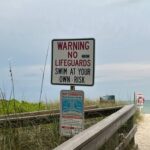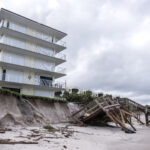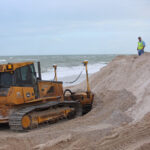INDIAN RIVER COUNTY – The five mayors in Indian River County would like to see the county’s leadership consider switching to artificial reefs rather than drawn out and costly beach replenishment projects.
“PEP reefs really have performed very well,” said Executive Director Jim Egan, of the Marine Resources Council.
There is a Prefabricated Erosion Prevention Reef off the shore of Vero Beach in front of Sexton Plaza that stretches south to Humiston Park. The reef was installed in 1996 and is about 3,000 feet long and about 250 feet off the shore.
The reef, according to Egan, has helped keep sand on the beaches in that area over the course of the last 15 years and has become a proven example of how an artificial reef can positively impact the environment.
“It will be up and down,” he said of the amount of sand on the protected beaches over time, “just as we see our beaches naturally.
The county’s mayors – representing each of the municipalities – asked for Egan to make a presentation about the reefs in order to better understand alternatives to beach replenishment.
Indian River County recently completed the second of what is expected to be three phases of renourishment along about 6.6 miles of beaches on the north end of the barrier island – from the Seaview Development south to John’s Island.
“We just can’t afford to dredge and pump,” Egan said, referring to government on a larger level cutting back funding assistance on such projects. “They realize it will never end.”
Egan said there is also growing public resistance to beach renourishment projects as they see the sand placed on the beaches and then swept back out to sea.
“They don’t get it – there’s the sand and there it goes,” he said. “They never have.”
Egan added that by demonstrating via a model how the reef or reefs could help recapture the sand and, over time, grow the beaches, the public might be more willing to support it.
Mayors Tom Cadden, of Indian River Shores, and Richard Dunlop, of Orchid, both expressed interest in getting a rough estimate on how much it would cost to have a model done to show where to place reefs and what their impact would be on their shoreline.
In all, the mayors agreed to extend the study area from about a mile north of County Road 510 to about 10 miles south, to the north side of the Vero Beach PEP reef.
Egan said he thought he could attain a “back of the envelope” quote from Dr. Gary Zarillo, an Florida Institute of Technology professor who is known for modeling such projects.
Dr. Zarillo had been involved in the Vero Beach PEP reef project.
Dunlop said that once the mayors are armed with a rough cost estimate, they could better gage whether to take the matter to the Board of County Commissioners and consider splitting the costs.
“We have to protect our infrastructure,” said Commissioner Joe Flescher, who attended the Mayors’ Meeting as a guest, given that his district includes the northern beaches of the barrier island.
He said he is excited by the discussion and looks forward to receiving more information.
Egan cautioned the mayors that the end cost for an artificial reef project could be in the same neighborhood as that of a beach replenishment project. He explained that the reefs, unlike the pumped sand, are much more permanent and their impact would be felt for a long time after the work were done.






